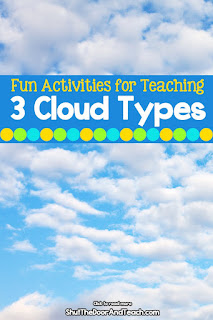I wonder how soon schools will stop buying textbooks in
favor of all the great information online.
I've never felt married to my science text before, but this year I have
found so much great online content for teaching weather to my fourth graders that I just had to
share!
 My "segue" to my weather unit always starts with a review
of solid liquid and gas. Then we talk
about the water cycle. Although science
books tend to have nice diagrams, I feel like they can't compete with an
animation. This year I showed my students this short video on the water cycle
as a whole class. Then I had them each go view
this water cycle animation to learn at their own pace. Since there is no sound, it was fine for a whole class to go on at
the same time on individual computers (we don't have enough headphones to go around). And they can take their time reading the
labeled parts and watching the arrows move.
My "segue" to my weather unit always starts with a review
of solid liquid and gas. Then we talk
about the water cycle. Although science
books tend to have nice diagrams, I feel like they can't compete with an
animation. This year I showed my students this short video on the water cycle
as a whole class. Then I had them each go view
this water cycle animation to learn at their own pace. Since there is no sound, it was fine for a whole class to go on at
the same time on individual computers (we don't have enough headphones to go around). And they can take their time reading the
labeled parts and watching the arrows move.
Next we always focus on clouds for a lesson. I give the kids a drawing lesson using clouds
and smart background color choices for paper, and they represent three cloud
types: Stratus, cumulus and cirrus. It's no accident that I placed the stratus
lowest and cirrus up high on the display, since their actual elevation is
relative in nature.
 This year, along with notes on all three, I also had the kids write a short note (it almost
could have been a text) to a friend asking them on a play date in two days, and
it had to be conducive to the type of weather they were expecting, based on the
cloud types. This was a big hit! It was a very short, to the point writing
assignment, and it was very relevant to their lives.
This year, along with notes on all three, I also had the kids write a short note (it almost
could have been a text) to a friend asking them on a play date in two days, and
it had to be conducive to the type of weather they were expecting, based on the
cloud types. This was a big hit! It was a very short, to the point writing
assignment, and it was very relevant to their lives.
 This year, along with notes on all three, I also had the kids write a short note (it almost
could have been a text) to a friend asking them on a play date in two days, and
it had to be conducive to the type of weather they were expecting, based on the
cloud types. This was a big hit! It was a very short, to the point writing
assignment, and it was very relevant to their lives.
This year, along with notes on all three, I also had the kids write a short note (it almost
could have been a text) to a friend asking them on a play date in two days, and
it had to be conducive to the type of weather they were expecting, based on the
cloud types. This was a big hit! It was a very short, to the point writing
assignment, and it was very relevant to their lives.
I let the kids know, "These are not the only 3 cloud
types that exist, so if you look in the sky and can't tell what they are one
day, don't feel bad. For that matter,
after learning the fourth grade unit on weather, please don't expect that you'll
be able to accurately predict the weather 100% of the time. Even the meteorologists can't do
that." They laugh, and I feel like
they do feel invested in learning what causes weather events, even though they
know they don't have the WHOLE story yet.
Next came a discussion on precipitation. I made a new anchor chart this year:
Instead of doing a demonstration on warm air rising and cold air sinking, I showed them this very short video involving the movement of hot and cold liquid, differentiated by colored food dye. Free, and no mess! Easy enough for kids to try at home.
Next we watched a fun little cartoon about fronts, a more realistic animation of cold and warm fronts, and our FAVORITE...BY FAR, was a parody of "Keep Your Head Up" by Andy Grammer, which is all about air masses and fronts. Most of it is way too advanced for fourth grade, (it was written and performed by a 6th grade science teacher) but it was great for my gifted
student, piqued the interest of my more curious students, and entertained my musical students! To keep it relevant I
just encouraged them to remember the bridge and they were happily singing
along.
 I knew the unit struck a chord when one of my students told me last week, "Mrs. Thomas, look, it rained, so now the stratus clouds are going away. We're going to have good weather. It will probably cool down, too."
I knew the unit struck a chord when one of my students told me last week, "Mrs. Thomas, look, it rained, so now the stratus clouds are going away. We're going to have good weather. It will probably cool down, too." 







Clouds are, in essence, massive collections of tiny water droplets and crystallized water molecules. As a cloud grows thicker, more sunlight is reflected from it and less light can penetrate through it. https://weatherstationpro.com
ReplyDelete